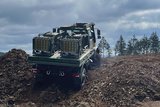Harris bags tactical radio orders
Harris Corporation has received two orders worth $29 million to deliver its Falcon tactical radios to an undisclosed European country, it announced on 28 April.
The radios were ordered as part of the country's standardisation programme to ensure interoperability with partners in coalition operations. Under the orders, the company will supply AN/PRC-117G multiband networking manpack radios, AN/PRC-152A wideband networking handheld radios and AN/PRC-150C HF/VHF tactical radios.
The AN/PRC-152A handheld radios provide high-speed networked, simultaneous and secure data and voice communications. The AN/PRC-117G manpack radios combine legacy narrowband, SATCOM and wideband networking interoperability to support multiple missions. The AN/PRC-150C HF/VHF radios provide long-range data and voice communications.
Chris Young, president, Harris Communication Systems, said: 'These radios will ensure that our customer has secure interoperability with US and NATO forces. With wideband networking capabilities, warfighters will gain improved situational awareness and access to a common operating picture.'
More from Digital Battlespace
-
![Babcock nears first customer for Nomad AI translation tool]()
Babcock nears first customer for Nomad AI translation tool
Nomad can provide militaries with real-time intelligence, saving critical time on the battlefield.
-
![AUSA 2025: Israel’s Asio Technologies to supply hundreds of improved Taurus tactical systems]()
AUSA 2025: Israel’s Asio Technologies to supply hundreds of improved Taurus tactical systems
Taurus operates alongside the Israel Defense Forces’ Orion system which supports mission management across tens of thousands of manoeuvring forces, from squad leaders to battalion commanders.
-
![AUSA 2025: Kopin pushes micro-LED plans as China moves faster]()
AUSA 2025: Kopin pushes micro-LED plans as China moves faster
The plan for the new displays follows fresh investment in Kopin’s European facilities by Theon and an order for head-up displays in fielded aircraft, with funding from the US Department of Defense.
-
![AUSA 2025: Persistent Systems to complete its largest order by year’s end]()
AUSA 2025: Persistent Systems to complete its largest order by year’s end
Persistent Systems received its largest ever single order for its MPU5 devices and other systems earlier this month and has already delivered the 50 units to the US Army’s 4th Infantry Division.
-
![Aselsan brings in dozens of companies and systems under the Steel Dome umbrella]()
Aselsan brings in dozens of companies and systems under the Steel Dome umbrella
Turkey has joined the family of countries attempting to establish a multilayered air defence system with government approval in August 2024 for the effort landed by Aselsan. Dubbed Steel Dome, the programme joins Israel’s Iron Dome, the US Golden Dome, India’s Mission Sudarshan Chakra and South Korea’s low-altitude missile defence system.
-
![DSEI 2025: MARSS unveils new agnostic multidomain C4 system]()
DSEI 2025: MARSS unveils new agnostic multidomain C4 system
MARSS’ NiDAR system has been deployed using sensors from static platforms to provide detection and protection for static sights, such as critical infrastructure, ports and military bases.


























